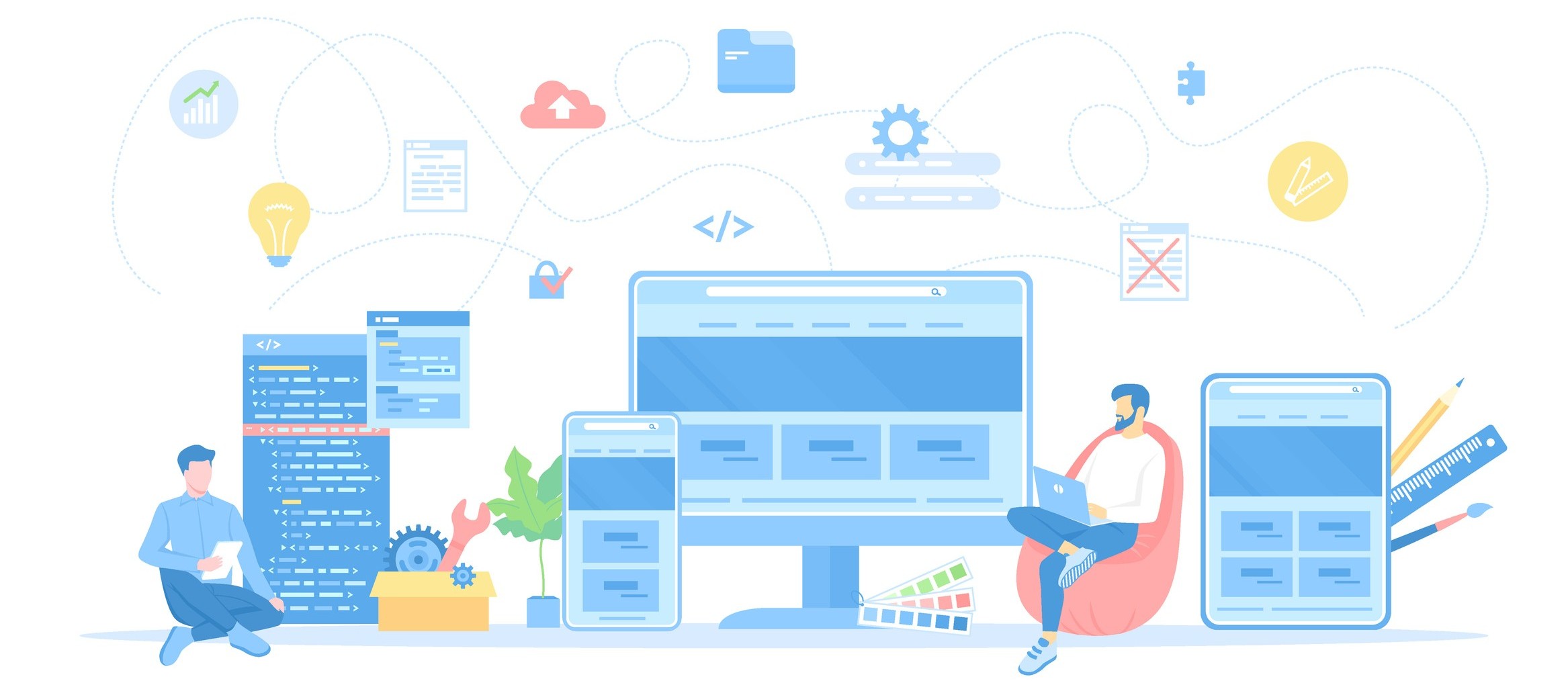User interface (UI) design is important for the success of any website or application. A well-designed UI enhances visual appeal and significantly improves user experience, making it easier for visitors to navigate and interact with the site. Effective UI design leads to higher user satisfaction, increased engagement, and better conversion rates. However, even experienced designers can make common mistakes that result in UI design errors.
Recognizing and avoiding these UI design errors is essential for creating a seamless and effective user experience.
Inadequate Navigation Design
Navigation is the backbone of any website or application, guiding users through the content and helping them find the information they need. A well-designed navigation system ensures that users can effortlessly explore the site, leading to a better overall experience. Conversely, poor navigation can frustrate users, causing them to leave the site prematurely.
Common Navigation Mistakes
- Too many menu items can overwhelm users and make it difficult to find what they are looking for.
- Unclear or vague labels can confuse users about the purpose of different sections.
- Hidden navigation elements, such as those buried in dropdown menus, can be easily overlooked.
- Inconsistencies in the navigation structure can lead to confusion and disorientation.
Solutions to Improve Navigation
- Simplify menu options by grouping related items together and limiting the number of primary menu items.
- Use clear and descriptive labels that accurately reflect the content of each section.
- Ensure that navigation elements are always visible and accessible, avoiding excessive use of dropdowns or hidden menus.
- Maintain a consistent navigation structure throughout the site to provide a cohesive user experience.
Poor Use of Colour and Contrast
Colour and contrast are vital elements in UI design, influencing both the aesthetic appeal and usability of a website or application. Proper use of colour can draw attention to important elements, create a visual hierarchy, and convey the brand's personality. Contrast ensures that text is readable and that elements stand out against their backgrounds, making it easier for users to navigate and interact with the interface.
Typical Mistakes in Colour Use
Despite their importance, colour and contrast are often misused, leading to a subpar user experience. Common UI design errors include using too many colours, insufficient contrast between text and background, and inconsistent colour schemes.
- Using an excessive number of colours can make the design look chaotic and confusing.
- Poor contrast between text and background can make content difficult to read.
- Inconsistent colour schemes can disrupt the visual coherence and brand identity.
Tips for Effective Colour Use
To create a visually appealing and user-friendly interface, it is essential to use colour and contrast effectively. This involves limiting the colour palette, ensuring adequate contrast, and maintaining consistency throughout the design.
- Limit the colour palette to a few complementary colours to create a cohesive and harmonious look.
- Use high contrast between text and background to ensure readability, especially for important content.
- Maintain a consistent colour scheme that aligns with the brand identity across all pages and elements.
- Use colour strategically to highlight key elements and guide users' attention.
- Consider accessibility guidelines, such as the Web Content Accessibility Guidelines (WCAG), to ensure that colour choices are inclusive for all users.
Overcomplicated Layouts
A simple and intuitive layout is crucial for creating a positive user experience. Simplicity in design helps users to easily find and understand the information they need, reducing cognitive load and enhancing usability. A clutter-free layout allows for better focus on key elements, making the site more accessible and enjoyable to navigate. Moreover, simple layouts tend to be more aesthetically pleasing and can lead to higher user engagement and satisfaction.
Common Layout Errors
Designers often make the mistake of overcomplicating layouts by trying to include too much information or too many elements on a single page. This can overwhelm users and detract from the overall effectiveness of the design.
- Overcrowded pages with too many elements
- Lack of whitespace, making the layout feel cluttered
- Poor alignment of elements, leading to a disorganized appearance
- Inconsistent use of layout grids and spacing
Strategies to Simplify Layouts
To create a clean and effective layout, it's important to prioritize simplicity and clarity. This involves focusing on the essential elements, using whitespace effectively, and ensuring consistent alignment and spacing throughout the design.
- Focus on essential elements by removing unnecessary content and features.
- Utilize whitespace to give elements room to breathe and improve readability.
- Ensure proper alignment of elements to create a clean and organized appearance.
- Use a consistent grid system to maintain uniform spacing and structure across the layout.
- Prioritize visual hierarchy to guide users' attention to the most important information first.
Ignoring Mobile Responsiveness
Mobile devices account for a significant portion of web traffic. Ensuring that your website or application is mobile-friendly is important for reaching a broader audience and providing a seamless user experience across all devices. Mobile responsiveness ensures that content is accessible and visually appealing, regardless of the screen size or device. A well-designed mobile interface can lead to higher user satisfaction, increased engagement, and better conversion rates.
Common Mistakes
Despite its importance, many designers still overlook mobile responsiveness, resulting in a poor user experience for mobile users.
- Non-responsive elements that do not adjust to different screen sizes
- Overly complex mobile layouts that are difficult to navigate
- Inconsistent user experience across various devices
- Slow loading times due to unoptimized mobile content
- Touch elements that are too small or too close together, making them hard to use
Best Practices for Mobile Design
To create an effective mobile-friendly design, it's essential to follow best practices that enhance usability and accessibility on mobile devices.
- Implement responsive design techniques to ensure elements adjust appropriately to different screen sizes.
- Simplify mobile layouts by prioritizing essential content and features.
- Maintain a consistent user experience across all devices by testing and optimizing the design for various screen sizes.
- Optimize images, videos, and other content to reduce loading times on mobile devices.
- Ensure touch elements are appropriately sized and spaced for easy interaction on touchscreens.
- Use flexible grids and layouts to adapt to different screen orientations and resolutions.
Neglecting Accessibility
Accessibility in UI design ensures that all users, including those with disabilities, can access and interact with a website or application effectively. It is not only a legal and ethical obligation but also a good design practice. Accessible design enhances user experience, broadens your audience, and improves your site's overall usability. By considering accessibility from the outset, you create an inclusive environment that accommodates the needs of all users, leading to higher satisfaction and engagement.
Common Accessibility Mistakes
Many designers overlook key accessibility principles, resulting in interfaces that are difficult or impossible for some users to navigate.
- Missing alternative text (alt text) for images
- Poor keyboard navigation, limiting accessibility for users who rely on keyboard inputs
- Inadequate colour contrast, making text hard to read for visually impaired users
- Lack of focus indicators for interactive elements
- Ignoring semantic HTML, which helps screen readers interpret the content correctly
Solutions to Enhance Accessibility
To create an accessible UI, it's essential to integrate accessibility best practices throughout the design and development process.
- Provide descriptive alt text for all images to ensure they are accessible to screen readers.
- Ensure smooth keyboard navigation by making all interactive elements accessible via keyboard.
- Use high-contrast color schemes to enhance readability for users with visual impairments.
- Implement clear focus indicators to help users understand which element is currently selected.
- Use semantic HTML to give meaning to content, aiding screen readers in interpreting the page structure correctly.
- Test the site with accessibility tools and real users to identify and fix accessibility issues.
Fixes for UI Design Errors
In UI design, avoiding common errors is essential for creating an effective and enjoyable user experience. Implementing these solutions will help you avoid common UI design errors and create a user interface that is both aesthetically pleasing and highly functional. By focusing on navigation, colour and contrast, layout simplicity, mobile responsiveness, and accessibility, you can significantly enhance the user experience and achieve better results for your projects.
Take the time to review your current designs and apply strategies to ensure your interfaces are user-friendly and inclusive. Doing so will not only improve usability but also broaden your audience and enhance overall satisfaction.




